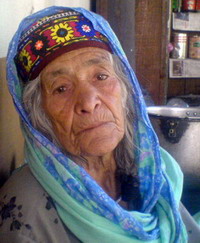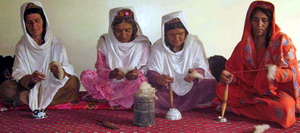Introducing Hunza Wear: I met Imamyar Baig in the dining room of Rawalpindi’s Al-Azam Hotel in 2006, a chance encounter en route to Peshawar in Pakistan’s Khyber Pakhtunkhwa Province. This big-hearted mountain man enthralled me with stories about his homeland, the Hunza Valley in what is now Gilgit-Baltistan , an autonomous region in far north-eastern Pakistan. He told me about his beloved Karakorum Mountains and their famous peaks, and about the impacts of 9/11 and the so-called ‘War On Terror’ on the trekking and tourism industries which local communities depended on for their economic survival. After 11 September 2001 these industries virtually collapsed, he told me, making already impoverished mountain communities even poorer.
And, as if this weren’t enough, the region suffered a massive earthquake five years later, which destroyed hundreds of villages, killed more than 70,000 people, and left thousands of survivors homeless. Then, in 2010, the side of a mountain fell into the Hunza River destroying yet more villages and farmland and leaving many more people homeless.
Imamyah Baig wanted to help these mountain communities, he told me, but what could he, just one man, do, I wondered. What could any of us do against such overwhelming forces? Well, my friend has found an answer: a very practical community-based intervention to offer mountain communities – especially mountain women – more sustainable livelihoods and many other benefits. I commend his still-evolving project to you, but I’ll let Baig tell you more about it himself.
THE HUNZA WEAR PROJECT: A CONCEPT PAPER
By Imamyar Baig
Project coordinator
Aliabad, Gilgit-Baltistan
May 2008, Jamadi-ul-Awwal 1429
The Hunza Wear Project is an indigenous community-based initiative by Hunza people to create sustainable livelihoods in the mountains of Gilgit-Baltistan, where communities are still suffering from the post-9/11 collapse of the tourism and trekking industries and the ripple effects of the 2005 Earthquake. And now they must also respond to the challenges Climate Change will bring.
This project will enable local women to develop their traditional spinning, knitting and needlework skills to produce high quality hand-crafted Western-style garments for sale in a global market under a single brand name: Hunza Wear.
Not only will the project create new local employment and capacity building opportunities, it will also conserve and foster traditional knowledge and skills; support on-going skills transmission and development, on-the-job training and further education; nurture pride and confidence in local cultures and traditions; promote the Hunza Valley nationally and internationally; and establish profitable links with the outside world.
PROJECT SETTING
The Hunza Wear Project is being conducted in the remote and isolated communities of the Karakoram, Hindu Kush and Pamir Ranges of northeastern Pakistan. The narrow Hunza Valley is surrounded by some of the world’s most awe-inspiring mountains. In winter this landscape is covered in deep snow.
The target area stretches from the top of the famous Khunjerab Pass on Pakistan’s border with China, to near Chitral on the Pakistan-Afghanistan border, a distance of some 300kms. The total population of this region is nearly 600,000 people, most of whom live well below Pakistan’s poverty line. Although the Hunza Wear Project currently focuses on the Hunza region of Pakistan, our future plans include expansion into neighbouring Afghanistan and Tajikistan.
The Hunza Wear administration and sales headquarters has been established in the town of Aliabad on the Karakoram Highway which is accessible to most people in the region.
TARGET GROUPS
The Hunza Wear Project will target the most marginalised groups in our high mountain communities, including the disabled, orphans and widows, with the aim of providing them with a sustainable source of income that is sufficient to allow them to live with dignity.
Some 25-30 local women have already participated in initial training, and Hunza Wear garments are now being produced in the villages of Hussainabad and Nasirabad in the Lower Hunza Valley; in Hassanabad, Aliabad, Ganish and Altit in Central Hunza; and in Ghulkin, Chipursan, Moorkhun and Shimshal in Upper Hunza. Garments are collected from these villages and taken to Aliabad for quality control, packaging and sale.
THE PROBLEM OF FAKE ‘HUNZA’ PRODUCTS
For some years a number of businesses have been marketing carpets, caps, gloves, sweaters and other mass-produced items to tourists as ‘genuine’ Hunza handicrafts. It is therefore difficult to find authentically hand-crafted goods for sale anywhere in the region. Locals are increasingly concerned that the mass-production and sale of fake ‘Hunza’ products is contributing to a loss of traditional skills, knowledge and pride, and is projecting a negative image of the region to the rest of the world. The Hunza Wear Project is committed to addressing these concerns by supporting the production of export quality hand-crafted goods by Hunza people to fulfill the needs both of local communities and of Westerners who desire authentic handicrafts.
SOURCING RAW MATERIALS
All wool for Hunza Wear garments is locally sourced. Sheep and goats have been herded in the Karakoram, Hindu Kush and Pamir Mountains for thousands of years, and traditionally it is the women who care of them. Every spring women take their flocks to the high grasslands and return with them to their villages at the end of summer. The animals are stalled in the villages over the long winters. Many of the mountain communities, such as Phandar in Ghizar District and the Yarkhun Valley in Chitral, own very large flocks of sheep and goats which will provide more than enough wool for the Hunza Wear Project. We may also be able to work with the pastoralists to improve wool production in the future.
SUPPORTING THE MOST IMPOVERISHED GROUPS
The Hunza Wear Project’s main objective is to address the needs of the most underprivileged groups in our communities. We plan to allocate a percentage of our profits (15 to 25 per cent) to support impoverished groups, including orphans, widows, disabled and the ‘poorest of the poor’. The funds will be spent on education and healthcare services and amenities for these groups.
HUNZA WEAR GARMENTS
The following Hunza Wear products are now either being produced by the women or are being considered.
1. Hand-knitted woollen sweaters for males and females
2. Hand-knitted cotton sweaters for males and females, including kids
3. Hand made cotton T-shirts (summer season)
4. Trousers and shirts made from imported cloth for males and females
5. Traditional trousers made from wash and wear fabric for the youth market
6. Hand-knitted socks and gloves (children and adults)
7. Shawls (hand made)
8. Gifts (full embroidery pencil cases, purses for males and females, pouches for carrying glasses, wooden spoons, forks, knives, plates and cups etc)
9. Any other viable product for which there is a demand
ONGOING COLLABORATIONS
The Hunza Wear team, including the artisans in our high mountain communities, thank all those who have been instrumental in bringing this project about. We continue to seek support from our many ‘stakeholders’ around the world to guide us in setting prices and marketing our brand globally. We welcome your suggestions and advice. Please email me if you can help in any way. Or would like to buy our products.
Imamyar Baig
Hunza Wear Project Coordinator
horizonpakistan[at]hotmail.com
May 2008, Jamadi-ul-Awwal 1429
More on Merrill’s project work >>
Page created 8 June 2008. Posted on this new site 23 January 2011. Last updated 16 May 2011. Permalink: https://merrillfindlay.com/?page_id=1405


